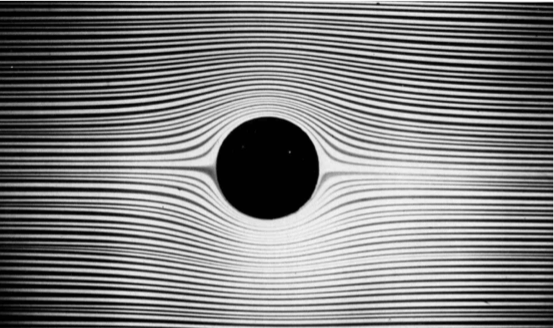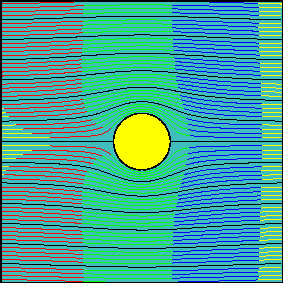Fluid dynamics for dummies, like me: on potential flows
Potential Flow Theory (PFT) has always had a bad reputation among most fluidynamicist, among other things, because it is quite abstract and has only been successfully applied to explain, more or less, basic concepts of fluid dynamics, more specifically in aerodynamics, mainly through low-order numerical methods, such as panel ones, including the "well-known" vortex lattice method (VLM).
Most lecturers teach during the fluid dynamics or computational aerodynamics courses that the PFT defines an irrotational (vorticity-free), incompressible (divergence-free) and inviscid (viscous-free) flow, which they call "ideal". However, its supposed inviscid characteristic is not theoretically defined and its current numerical implementation (including its attached circulation) is only a crude assumption! Such a misunderstanding can be demonstrated with a single image, from which it can be concluded that in fact, the current interpretation of the PFT has been used until now to solve its counterpart—I mean, the viscous case!!!, A BIG, A BIGGER, THE BIGGEST mistake in its interpretation that has been present since its conception around three centuries ago and has caused a serious delay in the development of Lagrangian vorticity-based methods, the most natural way to solve fluid dynamics!
The best-known example of the inconvenience caused by the current interpretation of the PFT is related to d'Alembert's "paradox", which in fact results in a fallacy. According to such a theory, it is not possible to obtain any force, including drag, in an "inviscid" flow past a cylinder, which is opposite to what is naturally expected. According to experience, an immersed object that moves inside a fluid exerts a drag force in the opposite direction to its path. But wait! Before you try to justify it due to the lack of fluid viscosity, please carefully take a look at the next image:
a) The physics are wrong! 😆
b) The experiment is wrong! 😟
c) The theory is wrong! 😢
Possible answers:
a) Probably not, at least not in this universe.
b) It is a possibility, but more related experiments appear in the same book with a similar pattern (see Fig. 6 at Re=0.16)...
c) If it is true, then we are worse than in the beginning. It's better not to think about it!
And with all this, what is the use of knowing? Well, check it out for yourself! (Click on each one):
- No more fallacies. Why do airplanes fly? ✈
- What is the 'hybrid vortex tube-vorton' method? 🌀
- Could there be lift force without viscosity? 👍
- How does the stall mechanism occurs? ☠
- Can vorticity only be generated along external separation lines? 🐤
- On detached potential flow and the d'Alembert's paradox 🤥
- Does the Coandă effect cause lift on an airfoil? 💭
- A four-question quiz: on fundamentals of fluid dynamics 📚





Hi Carlos, it is difficult to see what you're trying to argue here. The similarity between the flowfield images would break down simply by zooming in and finding the boundary layer. The main difference between a flow of a viscous fluid and of a perfect fluid is the boundary condition of adherence vs. non-penetration, respectively.
ReplyDeleteAlso how is the Euler-D'Alembert paradox a fallacy? I've read your post on the matter, but it wasn't really clear to me.
Hi! Perhaps what needs to be clarified is that I am referring to the macro scenario, not the micro one. Please give me some time to prepare a better explanation. Meanwhile, keep in mind the next four scenarios:
Delete1) Physical/hypothetical: the fluid-flow is totally viscous (Re=0), then there is no velocity (completely stagnant flow), no BL and no streamlines are present; the drag force is zero.
2) Physical; Stokes 'flow': the fluid-flow velocity is near (q-->0) to zero (Re-->0), thus, it cannot be already completely viscous (nu-->inf); the BL is just developed; it has an 'almost' infinitesimal thickness, despite the high viscosity, due to the low velocity (low shear stresses); drag force just appears (D-->0).
3) Current PFT: the flow is supposed to be completely inviscid (Re-->inf), thus no shear stresses despite the high velocity (or a large characteristic length). If it is supposed that BL cannot exist due to the inviscid condition*, no interaction with the surface is possible, and no drag force can be obtained. This solution is trivial since no matter the body's shape/streamline pattern, the result will always be the same.
4) New interpretation of the PFT: Since the flow is entirely attached to the surface, the fluid-flow is 'almost' completely viscous (Re-->0). The BL is confined to an infinitesimal thickness (it cannot grow due to the low fluid-flow velocity). This explanation matches the second scenario, the physical one.
*This is false because it can be theoretically demonstrated that vorticity (thus, circulation necessarily exists) can be generated from surfaces without a viscous medium, being a purely inviscid mechanism [Terrington et al., 2022].
I just answered the other question in the corresponding post.
Thanks for your interest!
First of all, thank you for your sharing your thoughts, which gave me the opportunity to do some very interesting reading.
DeleteI am looking forward to a more detailed post, and I would like to add here some considerations:
1) Everyone agrees that PFT is very useful for a "macro" description of flows
2) That the potential flow solution closely resembles the low Re flows and not the high Re ones has more to do with instability than with viscosity per se
3) in general, flows of inviscid and viscous fluids are qualitatively different, and the difference is big enough that Re has no meaning for inviscid fluids, not even as a limit.
4) the difference lies in the boundary conditions you impose, adherence vs non-penetration; on this, the work by Terrington and the related ones show that yes, viscosity does not generate vorticity, but the adherence condition is always imposed, which has a meaning only for viscous fluids.
5) irrotational viscous flow can exist, but only in some special cases where it manages to satisfy adherence.
Thank you for reading my blog and having a genuine interest in these topics. Now, I will write a brief discussion of your points with the intention of continuing to generate ideas, which in the end is what really matters.
Delete1) Yes, through the current accepted interpretation of PFT.
2) I am not sure about this, but in the end the PFT allows obtaining good agreement through potential methods (at least for lift force in the viscous range without any BL coupling) for simulations that operate in high Re (e.g., airfoils, wings or airplanes).
3) In the limit, a flow is a fluid without viscosity or even with a slight one (e.g., nu=0.000...001 and this continues to be a fluid despite the extremely low viscosity), and then you can use the Re definition. What I want to show here is that if we have some problems understanding a phenomenon exactly at its extreme points, we can always use limits. This way of thinking is more useful than it appears. I often use it!
4) From the current interpretation of PFT, the imposing of a non-penetration (zero normal velocity, thus tangential flow) BC is not related to an inviscid or viscous attribution of the flow but only to restrict its crossing/penetrating through the surface; I mean, a no-slip (adherence) of even free-slip BCs is not imposed explicitly in PFT; in any case, only the second one is imposed implicitly (from the current interpretation).
5) It can exist, but not in the scope of PFT but in the Navier-Stokes one, for example, through vortex methods.
By the way, I just published a new post (A four-question...) where I try to simplify my reasoning from an observational point of view. I also recommend the reference to the Coanda effect, in order to expand this order of ideas.
I have replied to some of those points in the comments of your newest post.
Delete3,4,5) About the boundary conditions, adherence is not imposed in PFT because it would over-constrain the equations and make irrotational motions (almost) impossible. It is imposed for (linearly) viscous fluids, making the problem well-posed, in accordance to experience; I'm setting aside particular flows (rarefied gas, non-linear viscous fluids) for which different boundary conditions should be imposed. So it's not a matter of "extreme points", it's two totally different approaches, especially from a mathematical point of view.
The behaviour of ideal fluids might be difficult to understand, but that's because we never see ideal fluids (at least in our daily life).
Thanks for maintaining the interest. I will try to answer there.
Delete